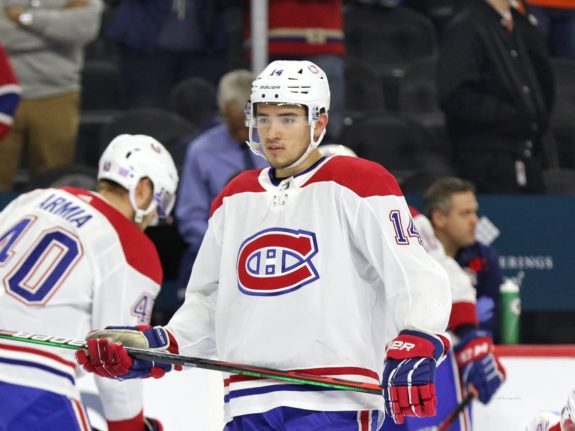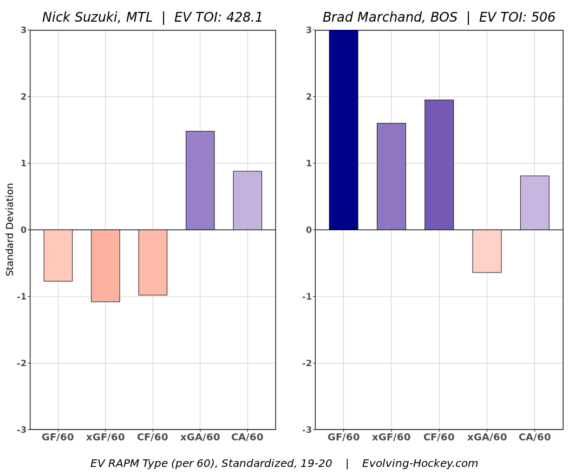The Montreal Canadiens came into the 2019-20 season with the expectation that they were heading back to the Stanley Cup playoffs. Which players were going to be playing in Montreal’s depth roles was the big question.
One player that people were not quite sure about making the team coming out of camp was Nick Suzuki. While he’s looked at as a big piece of the Canadiens’ future, Suzuki has slowly moved to being a part of the Canadiens’ present.
The hardest part for any player coming out junior and jumping right into the NHL is adjusting from playing against teenagers and young adults, to playing against professional men. Suzuki has shown that general manager Marc Bergevin, head coach Claude Julien, and company made the right decision to bring him up to the big club. Let us look at Suzuki’s performance through the first half of the season, reviewing his play offencively, defensively, and his overall potential in becoming a star player in this league.
Offence: A-
There is no question that Suzuki is an incredibly gifted offencive talent. This dates back to his career in the Ontario Hockey League where he scored 406 points in 309 games with the Owen Sound Attack and Guelph Storm. In his first season in Montreal, Suzuki has had steady production in his bottom-six role. While he is not at the point-per-game (P/GP) pace scouts saw back in his days in junior, Suzuki has shown that he can be a proficient scorer in the NHL.

Through the first 35 games of his NHL career, Suzuki has totaled seven goals and nine assists for 16 points. He is averaging 0.46 P/GP, and sits tied for seventh on the Canadiens roster in points with Jeff Petry. Suzuki is also getting league-wide recognition, as he is tied for sixth in the league in rookie scoring with the Carolina Hurricanes’ Martin Necas. Suzuki has not taken an extraordinary amount of shots, but when he does pull the trigger, he makes it count. His shooting percentage of 11.7% is right behind Jonathan Drouin, Tomas Tatar and Philip Danault for fourth on the Canadiens.
Defence: B+
One of the most surprising aspects of Suzuki’s game this season has been his responsibility without the puck. Many rookies are known to make egregious errors in the defencive end or make poor plays when breaking the puck out of their own zone. Granted, Suzuki is a minus-2 so far this season, yet he is rarely out on the ice when the Canadiens are scored against. This is shown in the RAPM chart below from Evolving Hockey.

Per Hockey-Reference, Suzuki has an expected goals-against of 13.2. This much lower compared to last season’s Selke Trophy winner and Stanley Cup champion, Ryan O’Reilly, who has an expected goals-against of 20.5. You can see how composed Suzuki is on the defencive side of the puck, as he always finds himself in the right position in the Montreal zone. He does a good job of not getting caught overreaching in the corners or up high, or leaving his man open around the net. Suzuki looks extremely confident while in his own zone, an important trait for a rookie centre.
Potential: A
In most cases, when a top-end junior talent makes his way into the professional ranks, they will start in the minors to hone their craft and develop in order to handle the rigors of pro hockey. If they are brought up too soon, it may stunt their development. Only in rare cases players will fit into the big club’s lineup, and have a positive impact while still fine-tuning their abilities. So far, Suzuki has been that rare case.

With his experience and maturity growing game-by-game, Suzuki will only continue to become a better player as the season wears on. Currently, he is only playing 14:41 a night, and for a player with Suzuki’s skill-set, it is only a matter of time before his minutes begin to rise above that mark. He has shown all the tools to be an everyday NHLer, but has the ability to grow into a high-scoring, two-way centre in this league. It may not be this season, but it will not be much longer before Suzuki starts to see his name in the top-six in the Canadiens’ lineup.